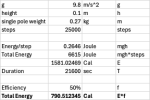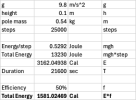I was a little surprised by your observation that you found a noticeable difference walking without them on flat terrain, suggesting this was because one wasn't using one's arms to lift them. That is true, but the poles will still be carried somewhere, and my view is that they might as well be achieving some benefit as none. That said, I can see that in the circumstance where one isn't using the straps effectively, and continually having to clasp and unclasp the handgrip to exert any force along the pole, that would become tiring far more quickly than exerting the downward force through the strap.
Certainly, as the article and logic says, a lot depends on the physical condition of the person we are talking about and the load on his shoulders.
When I wrote the comment in NERD MODE

I did not know whether
@Sijmon was young, old, in good or bad physical condition etc. In any case I wanted to share a study that I found interesting because I was surprised to read about his fear of walking for a day without hiking poles (and wrote it before he had found a solution).
I found it surprising because I have only recently (after joining this forum, actually) started using them even on level ground when walking (and not in the mountains, where I always use them... unless I forget them at home

). So for me the reverse problem - adapting to poles - arose, and I noticed that many miles on flat ground with poles fatigued my arms a little bit, also because I am not used to them, of course. Therefore, I thought that the problem was due to the fact that indeed the effort of lifting the poles by about ten cm tens of thousands of times (in 20 km you do 25000-30000 steps) was still not negligible. Doing a back-of-the-envelope account (I make no claim that this is a scientifically valid argument) it turned out that indeed, making some assumptions, the weight is felt (although some of it is recovered):

Note that this calculation, together with a number of assumption (I used the weight of my poles) does not include the effort of rotating the stick and carrying it forward but only the vertical component. This paper confirmed my impression.
On the other hand, when I was running, I had studied that it is best to try to swing no more than 5-10 cm vertically, which marathon runners do very well despite their very long strides (up to 2 meters).
To be honest, I am surprised that some people find this observation “curious.”, as a commenter wrote on another thread. It is clear that that extra half kg anyway represents “work” to be done with each stride, which benefits balance and also redistribution of effort but... still a work.
Finally, note that the paper talk about "large load", not just "a backpack". I do not know if 5-6 kg classifies as such.
 I have just arrived to Leon to start my walk tomorrow morning. Checked into accom and have found that one of my poles won't tighten when I extend it
I have just arrived to Leon to start my walk tomorrow morning. Checked into accom and have found that one of my poles won't tighten when I extend it  They are very basic telescopic ones you twist to open and close when extending or shortening.
They are very basic telescopic ones you twist to open and close when extending or shortening.






















